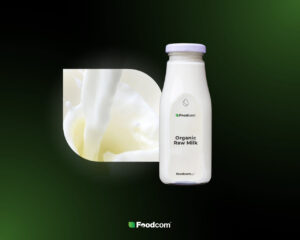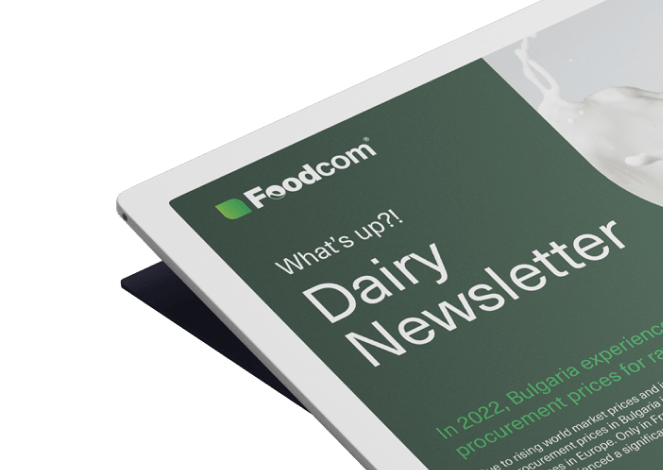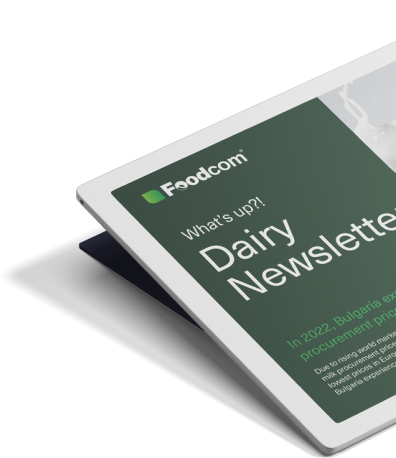- The global milk market will end 2025 in a state of oversupply, causing prices to fall and putting pressure on producers’ profitability.
- 2026 will be a period of stabilization and restructuring, with the sector accelerating consolidation and seeking new markets.
- Environmental regulations (CSRD, PPWR) and emission reduction requirements will change cost structures and production models in the EU and Oceania.
- Consumers are increasingly choosing value-for-money products and local and functional dairy products.
The global milk market enters the end of 2025 in a state of pronounced oversupply, which has wiped out previous price increases and worsened sentiment across the supply chain. Production in key regions – the US, EU and Oceania – has reached its highest level in a decade, while demand, particularly in Asia, has slowed. As a result, farmgate prices are falling faster than production costs, undermining the profitability of farms and processors. The situation is further complicated by trade tensions between the EU and China and the US and regulatory pressures in Europe. In the face of these challenges, the dairy sector is accelerating restructuring and looking for new markets as it prepares for a difficult 2026 transition year.
Global milk market analysis
The year 2025 ends with the largest increase in global milk production in five years. According to Rabobank data, production in the seven major export regions (‘Big-7’) increased by 1.6% y-o-y, and a further, albeit slower, increase of 0.6% is forecast for 2026. With China reducing imports and India and Southeast Asia becoming increasingly self-sufficient, there has been a surplus in the market that neither trade nor domestic consumption can absorb.
Raw material prices are falling on all continents. In the US, the ‘all milk’ price fell in the third quarter to around US$21/100 lbs, and the USDA forecast for 2026 is for a further decline to US$20.4. In the EU, the average farmgate price is now around €52-53/100 kg, compared to €56-58 in the spring, with Polish dairies reporting reductions of around €2-3 cents per month. On the global market, quotations for processed products (SMP, WMP, butter) remain under pressure – the FAO dairy index fell in September for the third consecutive month and GDT auctions remain at their lowest levels in two years.
Cost pressures remain high. Although energy and logistics prices have stabilised somewhat, farms continue to struggle with feed, fertiliser and credit costs. As a result, production margins are at their lowest since 2020. Many countries, especially in Central and Western Europe, are seeing the first decisions to reduce herds and merge smaller farms into larger cooperative units. Industry analysts speak plainly of the beginning of a new wave of dairy sector consolidation.
The demand side shows no signs of improvement so far. Consumers in the developed world – burdened by inflation and the high cost of living – are reducing their purchases of premium products, opting for cheaper milk and bulk cheeses. In Asia, on the other hand, after several years of rapid consumption growth, demand has stabilised at a lower level due to the economic slowdown and high domestic stocks in China.
The global market is becoming competitive to the limit. The US and New Zealand, struggling with their own surpluses, are increasing export activity, which is putting price pressure in Europe. The coming year 2026 will therefore bring not so much a rebound as a period of struggle to maintain liquidity and markets.
Regional analysis of the milk market
The market continued to experience weak demand for dairy products worldwide, exacerbated by economic pressures and high inflation affecting consumer purchasing power. The situation was particularly evident in developed markets and some key emerging markets.
Milk production growth was slow, exacerbated by logistical challenges and weather-related disruptions in some regions. There was no significant recovery in production or demand during the period.
Europe
European dairy is feeling the full force of oversupply. High production in France, Germany and Poland is met with limited exports to Asia due to China’s ongoing anti-subsidy investigation into EU dairy (extended until February 2026). Surplus products, especially dairy powders, remain on the internal market, resulting in further price falls and squeezed margins. In Poland and the Baltics, there are warnings of the risk of the smallest farms going out of business even before mid-2026.
North America
The quarter was characterised by cautious optimism in the dairy market, which is entering the next phase of the cycle. Prices showed the first signs of a slight rebound from minima, although overall market sentiment remained cautious due to ongoing geopolitical tensions, volatility in the energy market and weak macroeconomic conditions.
Supply growth was limited and reflected structural weaknesses in production in key export regions. This was accompanied by slightly improved but still weak demand.
Asia Pacific
China, which has driven global demand for years, is now maintaining a domestic production surplus and reducing imports. Self-sufficiency programmes have effectively reduced dependence on EU and Oceania supplies. In India, production continues to grow rapidly – the country has become the largest milk producer in the world. In New Zealand and Australia, high production is coupled with pressure on export prices; Fonterra forecasts an average milk price for the 2025/26 season in the range of NZD 9-11/kgMS, with considerable uncertainty about demand in Asia.
Latin America
Argentina and Uruguay maintain high production, but weakening currencies and rising logistics costs are reducing export profitability. Large export players dominate the region, but prices offered at tenders in Africa and the Middle East are falling, forcing renegotiation of contracts.
Trends and forecasts for 2026

The year 2026 will be a global challenge in which flexibility and speed of adaptation to new realities and changes will become crucial. Milk surpluses from the end of 2025 will continue to weigh on the market, keeping prices low and limiting producer profits until at least the middle of the year. Only in the latter part of the year can a gradual stabilisation be expected as exports absorb some of the stocks and production in Europe and Oceania begins to adjust under the impact of costs and environmental regulations. Even in the US, despite a strong export position, the market will remain under pressure from high inventories and weaker domestic demand.”
The trend towards consolidation and restructuring is becoming more pronounced in the structure of the industry. Smaller farms, especially in Central and Western Europe, are finding it increasingly difficult to remain profitable, leading to them gradually merging or abandoning production. Large, automated farms, which are able to react more quickly to cost changes due to their scale and investment in precision feeding technologies, are gaining in importance. This process is part of a wider structural transformation – from family farms to highly specialised producers capable of meeting environmental and quality requirements.
At the same time, 2026 will be a time of regulatory test for the dairy sector. In the European Union, key elements of the Environmental and Reporting Directives (CSRD, PPWR) will come into force, requiring producers to demonstrate their carbon footprint, energy efficiency and recyclability of packaging. While these regulations will increase operating costs, they will also become a ticket to premium segments and long-term contracts with retail chains. There is also increasing pressure in international markets to reduce methane emissions in milk production – particularly in New Zealand and Europe – which may affect herd policy and investment in breeding technology.
In the context of global trade, 2026 will bring a redesign of export destinations. The ongoing anti-subsidy investigation in China against EU dairy and the growing self-sufficiency of the Middle Kingdom will force exporters to look for new customers. Most efforts today are directed towards the markets of North Africa, the Middle East and South-East Asia. These regions, although promising, are at the same time very price-sensitive, which will result in fiercer competition between EU, US and Oceania exporters. This will make 2026 a year of competition for markets, where speed of delivery, contractual flexibility and the ability to adapt to local sanitary and environmental requirements will count.
On the consumer side, we will see the further development of the ‘value for money’ segment, i.e. good quality products at a moderate price. Fresh milk and basic dairy products – cheeses, yoghurts, butter – will remain the basis of consumption, but the increase in sales value will be generated mainly by local and functional products that fit in with a healthy lifestyle. The market for alternative sources of protein – plant-based beverages and precision fermented products – also continues to grow. Although low prices for conventional milk are temporarily holding back the expansion of these alternatives, the long-term trend towards flexible, sustainable diets remains unchanged.
Strategically, 2026 will therefore be a moment of review for dairy business models. Continued low prices, increasing regulatory requirements and changing consumer preferences will force companies to be more operationally flexible, invest in innovation and build added value around provenance, environmental footprint and transparency. Those who treat this year not as a crisis but as a period of transformation will gain an advantage in the new, more challenging phase of the global milk market.
Foodcom S.A. Global Reports
Curious about what the future holds for the milk market? Discover the latest trends and insights that will shape the dairy industry in 2024 and beyond. Visit our blog, where we regularly publish dairy market updates and analysis. Stay tuned to Foodcom S.A. for the latest news!
![Milk market overview 2026 [Global Report] Milk market overview 2026 [Global Report]](https://foodcom.pl/wp-content/uploads/2024/04/global-report-MILK-min.png)







